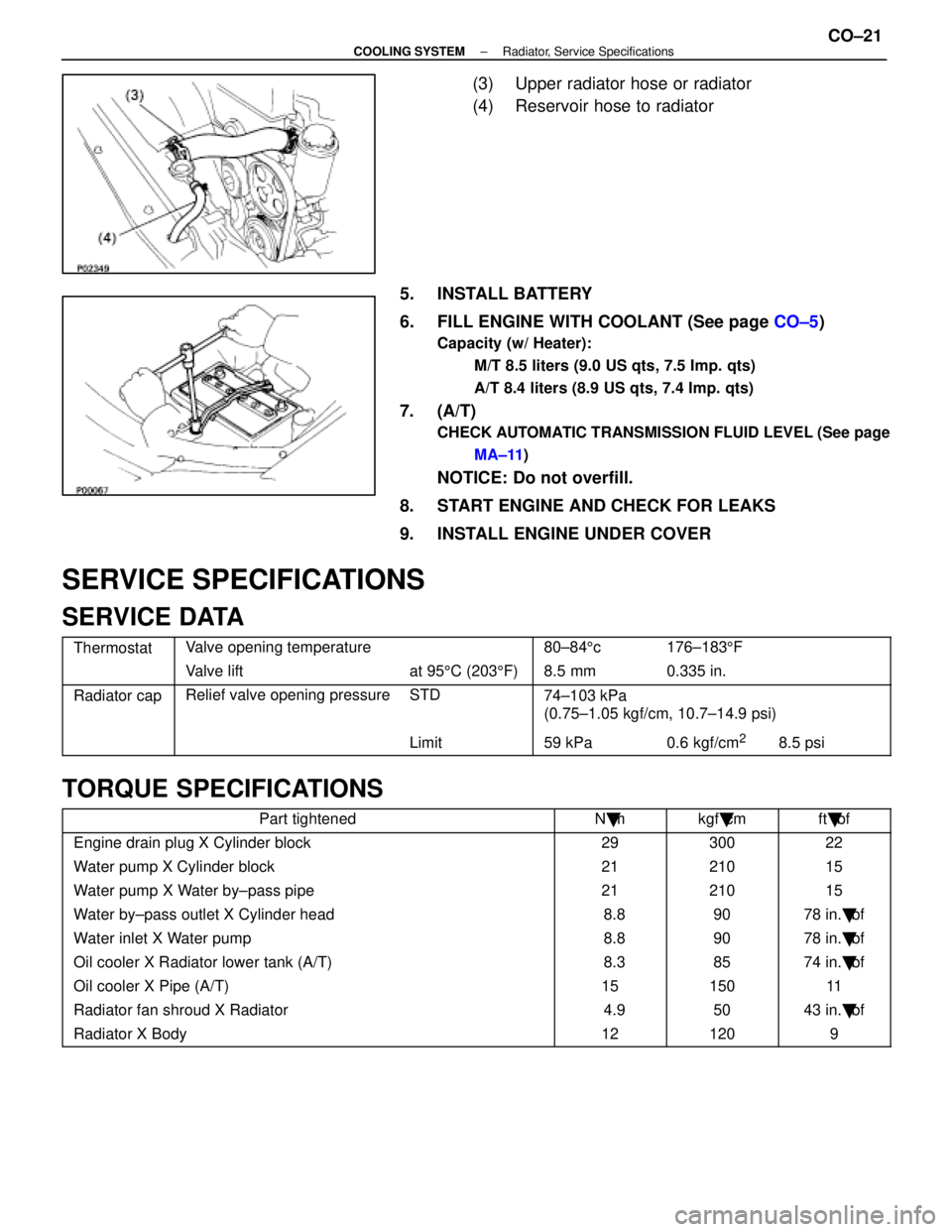Page 1277 of 4087
REMOVAL OF RADIATOR
(See Components on page CO±15)
1. REMOVE BATTERY CAUTION: Work must be started after approx. 20 seconds or
longer from the time the ignition switch is turned to the
ºLOCKº position and the negative (±) terminal cable is dis-
connected from the battery.
2. REMOVE ENGINE UNDER COVERS
3. DRAIN ENGINE COOLANT (See page CO±6)
4. REMOVE RADIATOR RESERVOIR TANK (a) Disconnect the coolant level sensor connector.
(b) Disconnect the following hoses:(1) Reservoir hose from water inlet housing
(2) Reservoir hose from radiator
(c) Remove the two bolts and reservoir tank bracket.
(d) Disconnect the reservoir tank from the reservoir tank bracket, and remove the reservoir tank.
5. DISCONNECT HOSES Disconnect the following hoses:(1) Upper radiator hose from radiator
(2) Lower radiator hose from radiator
(3) Two oil cooler hoses (for A/T) from radiator. Plug hose end.
CO±16
±
COOLIING SYSTEM Radiator
WhereEverybodyKnowsYourName
Page 1281 of 4087
(3) Two oil cooler hoses (for A/T) to radiator.
(4) Lower radiator hose to radiator
(5) Upper radiator hose to radiator
7. INSTALL RADIATOR RESERVOIR TANK (a) Install the reservoir tank to the reservoir tank bracket.
(b) Install the reservoir tank bracket with two bolts.
Torque: 4.9 N Vm (50 kgf Vcm, 43 in. Vlbf)
(c) Connect the following hoses:
(1) Reservoir hose to water inlet housing
(2) Reservoir hose to radiator
(d) Connect the coolant level sensor connector.
8. INSTALL BATTERY
CO±20
±
COOLIING SYSTEM Radiator
WhereEverybodyKnowsYourName
Page 1282 of 4087
9. FILL ENGINE WITH COOLANT (See page CO±7)
10. FILL COOLING FAN RESERVOIR TANK WITH FLUID (See pages CO±23 and 24)
11. CHECK AUTOMATIC TRANSMISSION FLUID LEVEL
(See page MA±11)
NOTICE: Do not overfill.
12. START ENGINE AND CHECK FOR LEAKS
13. INSTALL ENGINE UNDER COVER
±
COOLIING SYSTEM RadiatorCO±21
WhereEverybodyKnowsYourName
Page 1283 of 4087

(3) Upper radiator hose or radiator
(4) Reservoir hose to radiator
5. INSTALL BATTERY
6. FILL ENGINE WITH COOLANT (See page CO±5)
Capacity (w/ Heater):
M/T 8.5 liters (9.0 US qts, 7.5 Imp. qts)
A/T 8.4 liters (8.9 US qts, 7.4 Imp. qts)
7. (A/T)
CHECK AUTOMATIC TRANSMISSION FLUID LEVEL (See pageMA±11 )
NOTICE: Do not overfill.
8. START ENGINE AND CHECK FOR LEAKS
9. INSTALL ENGINE UNDER COVER
SERVICE SPECIFICATIONS
SERVICE DATA
ThermostatValve opening temperature80±84 5c176±183 5F
Valve liftat 95 5C (203 5F) 8.5 mm0.335 in.
Radiator capRelief valve opening pressureSTD74±103 kPa
(0 75 1 05 k f/ 10 7 14 9 i)(0.75±1.05 kgf/cm, 10.7±14.9 psi)
Limit59 kPa0.6 kgf/cm28.5 psi
TORQUE SPECIFICATIONS
Part tightenedN �mkgf �cmft �lbf
Engine drain plug X Cylinder block2930022
Water pump X Cylinder block2121015
Water pump X Water by±pass pipe2121015
Water by±pass outlet X Cylinder head 8.89078 in. �lbf
Water inlet X Water pump 8.89078 in. �lbf
Oil cooler X Radiator lower tank (A/T) 8.38574 in. �lbf
Oil cooler X Pipe (A/T)1515011
Radiator fan shroud X Radiator 4.95043 in. �lbf
Radiator X Body121209
±
COOLING SYSTEM Radiator, Service SpecificationsCO±21
WhereEverybodyKnowsYourName
Page 1310 of 4087
REMOVAL OF HYDRAULIC MOTOR
(See Components on page CO±47)
1. REMOVE BATTERY CAUTION: Work must be started after approx. 20 se-
conds or longer from the time the ignition switch is
turned to the ºLOCKº position and the negative (±) termi-
nal cable is disconnected from the battery.
2. REMOVE ENGINE UNDER COVERS
3. DRAIN ENGINE COOLANT (See page CO±6)
4. REMOVE RADIATOR RESERVOIR TANK (a) Disconnect the coolant level sensor connector.
(b) Disconnect the following hoses:(1) Reservoir hose from water inlet housing
(2) Reservoir hose from radiator
(c) Remove the two bolts and reservoir tank bracket.
(d) Disconnect the reservoir tank from the reservoir tank bracket, and remove the reservoir tank.
5. DISCONNECT HOSES Disconnect the following hoses:(1) Upper radiator hose from radiator
(2) Pressure hose from hydraulic motor
(3) Return hose from hydraulic motor
CO±48
±
COOLIING SYSTEM Electronically Controlled Hydraulic Cooling Fan
(Hydraulic Motor)
WhereEverybodyKnowsYourName
Page 1319 of 4087
7. INSTALL RADIATOR RESERVOIR TANK(a) Install the reservoir tank to the reservoir tank bracket.
(b) Install the reservoir tank bracket with two bolts.
Torque: 4.9 N Vm (50 kgf Vcm, 43 in. Vlbf)
(c) Connect the following hoses:
(1) Reservoir hose to water inlet housing
(2) Reservoir hose to radiator
(d) Connect the coolant level sensor connector.
8. INSTALL BATTERY
9. FILL ENGINE WITH COOLANT (See page CO±7)
10. FILL COOLING FAN RESERVOIR TANK WITH FLUID
(See pages CO±23 and 24)
11. START ENGINE AND CHECK FOR LEAKS
12. INSTALL ENGINE UNDER COVER
±
COOLIING SYSTEM Electronically Controlled Hydraulic Cooling Fan
(Hydraulic Motor)CO±57
WhereEverybodyKnowsYourName
Page 1355 of 4087
EXHAUST GAS RECIRCULATION (EGR) SYSTEM
DESCRIPTION
To reduce NOx emission, part of the exhaust gases are recirculated through\
the EGR valve to the intake
manifold to lower the maximum combustion temperature.
OPERATION
Coolant Temp.ConditionEGR ValveExhaust Gas
Below 53 5C (127 5F)±CLOSEDNot recirculated
Above 55 5C (131 5F)(a)Idling, Deceleration, Neutral,
Low air volume, High Engine speedCLOSEDNot recirculatedAbove 55 C (131 F)
Except (a)OPEN*Recirculated
* The ECU calculates the appropriate number of steps according to the in\
take air volume and the engine speed, then
drives the stepping motor to maintain the EGR volume at a level appropri\
ate to the driving conditions.
±
EMISSION CONTROL SYSTEMS Exhaust Gas Recirculation (EGR) SystemEC±15
WhereEverybodyKnowsYourName
Page 1380 of 4087

The 1 UZ±FE engine has 8±cylinders in a V±arrangement at a bank an\
gle of 905. From the front of the RH
bank cylinders are numbered 2 ± 4 ± 6 ± 8, and from the front of t\
he LH bank cylinders are 1 ± 3 ± 5 ± 7.
The crankshaft is supported by 5 bearings inside the crankcase. These beari\
ngs are made of a copper and
lead alloy.
The crankshaft is integrated with 8 weights for balance. Oil holes are plac\
ed in the center of the crankshaft
to supply oil to the connecting rods, bearing, pistons and other component\
s.
The ignition order is 1 ± 8 ± 4 ± 3 ± 6 ± 5 ± 7 ± 2. T\
he cylinder head is made of alminum alloy, with a cross
flow type intake and exhaust layout and with pent±roof type combustion chambers. The spark plugs are
located in the center of the combustion chambers.
At the front and rear of the intake manifold, a water passage has been p\
rovided which connects the RH
and LH cylinder heads.
Exhaust and intake valves are equipped with irregular pitch springs made\
of special valve spring carbon
steel which are capable of functioning at all engine speeds.
The RH and LH intake camshaft are driven by a timing belt, and a gear on\
the intake camshaft engages
with a gear on the exhaust camshaft to drive it. The cam journal is supp\
orted at 5 (intake) or 4 (exhaust)
places between the valve lifters of each cylinder and on the front end o\
f the cylinder head. Lubrication of
the cam journals and gears is accomplished by oil being supplied through th\
e oiler port in the center of the
camshaft.
Adjustment of the valve clearance is done by means of an outer shim type\
system, in which valve adjusting
shims are located above the valve lifters. This permits replacement of the sh\
ims without removal of the
camshafts.
Pistons are made of high temperature±resistant aluminum alloy, and a depression is built into the piston
head to prevent interference with the valves.
Piston pins are the full±floating type, with the pins fastened to neither the piston boss nor the connecting
rods. Instead, snap rings are fitted on both ends of the pins, preventing the\
pins from falling out.
The No.1 compression ring is made of steel and the No.2 compression ring\
is made of cast iron. The oil
ring is made of a combination of steel and stainless steel. The outer diamet\
er of each piston ring is slightly
larger than the diameter of the piston and the flexibility of the rings allows them to hug the cylinder walls
when they are mounted on the piston. Compression rings No.1 and No.2 work to\
prevent gas leakage from
the cylinder and the oil ring works to scrape oil off the cylinder walls to prevent it from entering the combus-
tion chambers.
The cylinder block is made of aluminum alloy with a bank of 90 5. Cast iron cylinders are installed inside
the cylinder block. It has 8 cylinders which are approximately twice the le\
ngth of the piston stroke. The top
of each cylinder is closed off by the cylinder head and the lower end of the cylinders becomes the crank-
case, in which the crankshaft is installed. In addition, the cylinder block c\
ontains a water jacket, through
which coolant is pumped to cool the cylinders.
The No.1 and No.2 oil pans are bolted onto the bottom of the cylinder bl\
ock. The No.1 oil pan is made of
aluminum alloy. The No.2 oil pan is an oil reservoir made of pressed steel sheet. An o\
il level sensor is
installed in the No.1 oil pan (If oil level drops below a set level, a warning light\
s up.). And oil pan baffle plate
keeps sufficient oil in the bottom of the No.2 oil pan even when the vehicle is t\
ilted. This dividing plate also
prevents the oil from marking waves when the vehicle is stopped suddenly\
and the oil shifts away from the
oil pump suction pipe.
Plastic region tighten bolts are used for the cylinder head, main bearin\
g cap and connecting rod.
EG±4
±
1UZ±FE ENGINE ENGINE MECHANICAL
WhereEverybodyKnowsYourName